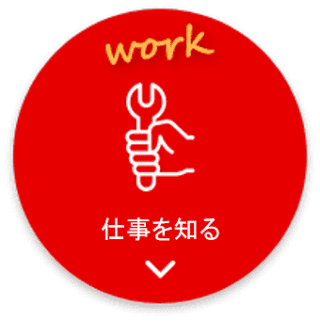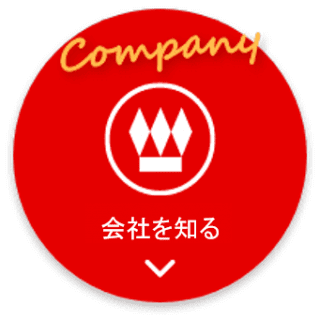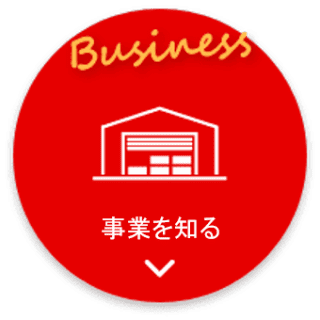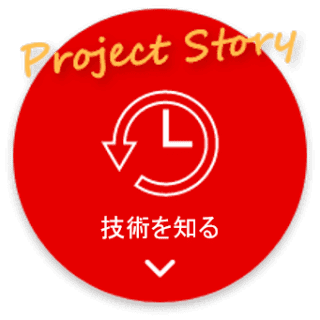Learn About Our Technology
project story
"Development of dye for plasma display optical filter dimming"
PROJECT MEMBER
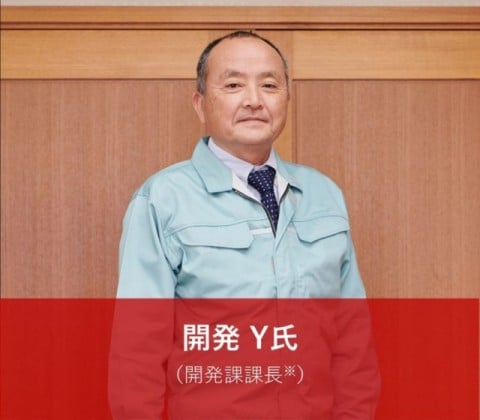
(In charge of sales at the time of dye development)
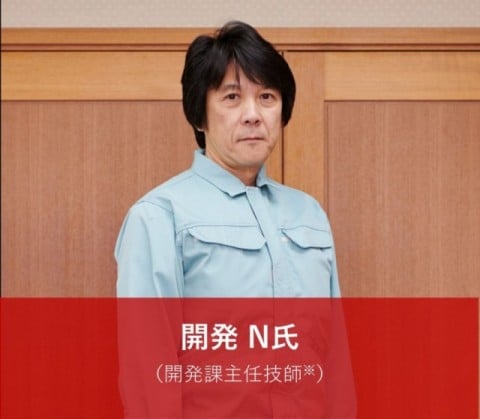
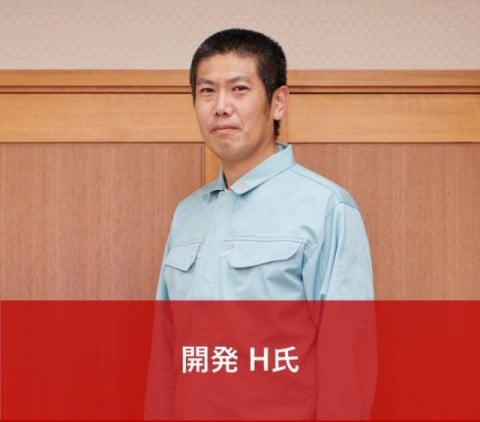
(At the time of pigment development, the process went from development to production technology)
(*At the time of interview)
Prologue: In the early 2000s, the battle for next-generation TV standards was intensifying.
─ Around the time the Western calendar reaches the 2000s. A wave of great change was occurring in social life. Television displays began to transition from cathode ray tubes to flat-screen monitors. At the time, flat-screen TVs had LCD and plasma display systems, and with the tailwind of terrestrial digitalization, competition between LCD and plasma TVs was intensifying among home appliance manufacturers.
Going back a little bit, Yamada Chemical developed "Dye A" used in optical recording materials such as CD-Rs in the late 1990s. It was supposed to be developed into a digital recording material that can be read and written with a laser, but development was stalled due to a change in the user's method. This is the story of such an era.
Going back a little bit, Yamada Chemical developed "Dye A" used in optical recording materials such as CD-Rs in the late 1990s. It was supposed to be developed into a digital recording material that can be read and written with a laser, but development was stalled due to a change in the user's method. This is the story of such an era.
Product development that had stalled - Discovering new uses and moving on to the next development
──N from the development department has been involved in the development of ``Dye A'', which has properties not found in conventional dyes, and has synthesized a huge number of samples. Even though development had stalled, he was wondering if the technology could be used for other purposes, since it would be a shame to let it go dormant. One day, I received a request from Y in sales to propose a dye for an optical filter for a new display.
Y (sales)
When a customer asked if there was a pigment with these characteristics, the product that came to mind as a potential match was "Pigment A," which N-kun et al. had developed for a different purpose in the 1990s. . When we took it to the customer and had them evaluate it, we realized that it looked like it could be used.
When a customer asked if there was a pigment with these characteristics, the product that came to mind as a potential match was "Pigment A," which N-kun et al. had developed for a different purpose in the 1990s. . When we took it to the customer and had them evaluate it, we realized that it looked like it could be used.
N (Development)
It was originally developed for about three years as an optical recording dye, but it remained dormant as it was difficult to adapt it to that use. The idea came to me through sales, but when I thought about mass production, at first I was worried about whether it would be possible.
Y (sales)
At that time, plasma and liquid crystal were competing with each other. Yamada Chemical's dyes are essential for plasma TVs to improve picture quality. However, at that time, LCD televisions did not require our dyes. Therefore, we decided to compete where it was needed.
It was originally developed for about three years as an optical recording dye, but it remained dormant as it was difficult to adapt it to that use. The idea came to me through sales, but when I thought about mass production, at first I was worried about whether it would be possible.
Y (sales)
At that time, plasma and liquid crystal were competing with each other. Yamada Chemical's dyes are essential for plasma TVs to improve picture quality. However, at that time, LCD televisions did not require our dyes. Therefore, we decided to compete where it was needed.
Started product development - Overcoming successive difficulties
──Even though they started developing the product, things did not go smoothly. Difficulties arose one after another, such as the need to improve ``Dye A,'' which N had previously developed, for next-generation use.
N (Development)
For the next generation, the manufacturing of intermediate products before final products did not go well. The reason is that unusable by-products were also created at the same time. I didn't know what to do, so I had a really hard time changing the reaction conditions over and over again.
──The person who helped me find the answer was H, who now works in the manufacturing department. At the time, he belonged to the development department and worked under N.
H (production technology)
At that time, I couldn't see the exit at all, so I felt like I was groping along a pitch-black road. One day, when I was really at a loss because even though I tried various conditions under N's instructions, nothing worked, I came across a condition that made me think, ``Isn't this good?'' When I found it, I was completely shocked. I remember feeling both happy and relieved that I had finally found a clue.
--Light has finally shined on the development. But then a new challenge arose. How can we mass-produce a successfully developed product?
H (production technology)
After gaining an introduction to on-site manufacturing, I moved to my current position in the production engineering department. The production volume, which was previously very small, must be increased many times over, and costs must also be reduced. The key point was how to mass-produce large-sized products at low cost. The hurdles for mass production are already high, and if Yamada Chemical has to use equipment and machines that they already own, their options become increasingly limited. At this time, too, it was a pitch dark road.
──In the face of numerous difficulties, the company at the time considered outsourcing some of the work. But he didn't think that was a good thing. What was there was the determination and pride of Yamada Chemical, a company based in chemistry.
Y (sales)
In order to somehow manage to do it ourselves, we asked people from the manufacturing department to tour other companies' factories. After seeing information that we didn't have, we thought, ``Maybe we can do this in-house.'' If we can't get the response we're aiming for anywhere else in the world, we may have to give up. However, if there is a company that can do it, then we should be able to do it too. That was a big challenge.
At that time, I couldn't see the exit at all, so I felt like I was groping along a pitch-black road. One day, when I was really at a loss because even though I tried various conditions under N's instructions, nothing worked, I came across a condition that made me think, ``Isn't this good?'' When I found it, I was completely shocked. I remember feeling both happy and relieved that I had finally found a clue.
--Light has finally shined on the development. But then a new challenge arose. How can we mass-produce a successfully developed product?
H (production technology)
After gaining an introduction to on-site manufacturing, I moved to my current position in the production engineering department. The production volume, which was previously very small, must be increased many times over, and costs must also be reduced. The key point was how to mass-produce large-sized products at low cost. The hurdles for mass production are already high, and if Yamada Chemical has to use equipment and machines that they already own, their options become increasingly limited. At this time, too, it was a pitch dark road.
──In the face of numerous difficulties, the company at the time considered outsourcing some of the work. But he didn't think that was a good thing. What was there was the determination and pride of Yamada Chemical, a company based in chemistry.
Y (sales)
In order to somehow manage to do it ourselves, we asked people from the manufacturing department to tour other companies' factories. After seeing information that we didn't have, we thought, ``Maybe we can do this in-house.'' If we can't get the response we're aiming for anywhere else in the world, we may have to give up. However, if there is a company that can do it, then we should be able to do it too. That was a big challenge.
Finally completed - products equipped with the product go to market
---After the tireless efforts of each department, mass production is in sight, and plasma TVs equipped with Yamada Chemical's dyes are finally starting to appear in stores. The news spread throughout the company in an instant, and the employees, both those directly involved and those not, were very excited.
H (production technology)
It wasn't as exaggerated as a scene from a TV drama (lol), but the elation within the company when the product was completed was truly amazing. It's been more than 20 years since I joined the company, but to date, nothing has surpassed the sense of accomplishment I felt at that moment. When I have drinks with everyone I worked with from that time, we often talk about those days.
H (production technology)
It wasn't as exaggerated as a scene from a TV drama (lol), but the elation within the company when the product was completed was truly amazing. It's been more than 20 years since I joined the company, but to date, nothing has surpassed the sense of accomplishment I felt at that moment. When I have drinks with everyone I worked with from that time, we often talk about those days.
N (Development)
When plasma TVs equipped with dyes came out, I couldn't help but look at the display from the side. When I saw that the color of the dye we had developed appeared, I thought it was amazing. When we started development, we were struggling just to make a few milligrams, but I couldn't believe that we could make it on a kilometer scale. When the product was launched on the market, I felt a sense of accomplishment and was very moved.
H (production technology)
When products equipped with our dyes came on the market, I often went to electronics stores. “Which one is mine?” I thought. I was also one of those strange customers who was looking at the display from the side instead of looking at the price tag (lol).
Y (sales)
For sales at a chemical manufacturing company like ours, we have nothing to sell unless people make it on-site. Everyone at the site responded with sincerity, and I am truly grateful. Sales is sometimes said to be lonely, but my background in Yamada Chemical makes it less so. Everyone will do something. Everyone helps me. The spirit of the company's motto of ``Wa-kei'' is clearly expressed here. The company's traditions and culture are passed down to everyone.
When plasma TVs equipped with dyes came out, I couldn't help but look at the display from the side. When I saw that the color of the dye we had developed appeared, I thought it was amazing. When we started development, we were struggling just to make a few milligrams, but I couldn't believe that we could make it on a kilometer scale. When the product was launched on the market, I felt a sense of accomplishment and was very moved.
H (production technology)
When products equipped with our dyes came on the market, I often went to electronics stores. “Which one is mine?” I thought. I was also one of those strange customers who was looking at the display from the side instead of looking at the price tag (lol).
Y (sales)
For sales at a chemical manufacturing company like ours, we have nothing to sell unless people make it on-site. Everyone at the site responded with sincerity, and I am truly grateful. Sales is sometimes said to be lonely, but my background in Yamada Chemical makes it less so. Everyone will do something. Everyone helps me. The spirit of the company's motto of ``Wa-kei'' is clearly expressed here. The company's traditions and culture are passed down to everyone.
Epilogue ~Challenge to the future
--Completion is the goal. However, it is also the starting point for the next step. The moment those working at Yamada Chemical cross the finish line, they begin a new challenge.
N (Development)
As a development department, we want to take on the challenge of the next dimension. I would like to move forward with development that involves finding new functions, not just coloring. It's fine to seek only cutting-edge technology, but sometimes you find yourself surprising yourself with older technology. Both the dyes for plasma displays and the recording dyes for CD-Rs that we had developed before that were classical materials originally used for coloring purposes. This led to the discovery of new functions and the development of new uses. I think the key to finding new uses is always opening the door to your interests and seeing things from a new perspective. It is important to keep your ideas flexible and to focus on many points before taking on the next challenge.
H (production technology)
In addition to mass-producing products developed in-house, we have recently been receiving more and more opportunities to receive direct inquiries from customers asking if we could make something like this. Many of these include reactions that we have never tried before, or techniques that we have never put into practice. I would like to take on such challenges and expand the range of Yamada Chemical's technology. Doing so will also expand the range of development. Even if a developed product is completed, we never want to say that ``Yamada Chemical cannot make it.''
Y (sales)
Receive orders from distributors and deliver goods. That was Yamada Chemical's traditional business style. However, customer requests have become more diverse with the times, and recently we have begun to receive requests directly from customers. In order to respond to these needs, we visit our customers, discover their needs, propose our own materials, and bring that feedback back to the company. So, the tide is changing. If we continue to do what we have always done, we will not be able to predict what will happen 10 or 20 years from now. We must always move forward.
N (Development)
As a development department, we want to take on the challenge of the next dimension. I would like to move forward with development that involves finding new functions, not just coloring. It's fine to seek only cutting-edge technology, but sometimes you find yourself surprising yourself with older technology. Both the dyes for plasma displays and the recording dyes for CD-Rs that we had developed before that were classical materials originally used for coloring purposes. This led to the discovery of new functions and the development of new uses. I think the key to finding new uses is always opening the door to your interests and seeing things from a new perspective. It is important to keep your ideas flexible and to focus on many points before taking on the next challenge.
H (production technology)
In addition to mass-producing products developed in-house, we have recently been receiving more and more opportunities to receive direct inquiries from customers asking if we could make something like this. Many of these include reactions that we have never tried before, or techniques that we have never put into practice. I would like to take on such challenges and expand the range of Yamada Chemical's technology. Doing so will also expand the range of development. Even if a developed product is completed, we never want to say that ``Yamada Chemical cannot make it.''
Y (sales)
Receive orders from distributors and deliver goods. That was Yamada Chemical's traditional business style. However, customer requests have become more diverse with the times, and recently we have begun to receive requests directly from customers. In order to respond to these needs, we visit our customers, discover their needs, propose our own materials, and bring that feedback back to the company. So, the tide is changing. If we continue to do what we have always done, we will not be able to predict what will happen 10 or 20 years from now. We must always move forward.
Toward a better future - To everyone who will lead the future
N (Development)
The qualities needed to be involved in development are meticulousness and the tenacity to carefully collect data. These days, we live in an era where we can understand everything on our smartphones. That's all well and good, but it's best to thoroughly research a topic through literature research and other methods before starting work. In addition to this attitude, we also want to have flexible thinking and a broad perspective. We are a company that tries positively and is tolerant of failure. I also made a mistake when I was young, which led to the discovery of a manufacturing method that is still in use today.
Y (sales)
Our company believes that something can be created from failure. It's important to tackle everything without fear of failure.
The qualities needed to be involved in development are meticulousness and the tenacity to carefully collect data. These days, we live in an era where we can understand everything on our smartphones. That's all well and good, but it's best to thoroughly research a topic through literature research and other methods before starting work. In addition to this attitude, we also want to have flexible thinking and a broad perspective. We are a company that tries positively and is tolerant of failure. I also made a mistake when I was young, which led to the discovery of a manufacturing method that is still in use today.
Y (sales)
Our company believes that something can be created from failure. It's important to tackle everything without fear of failure.
H (production technology)
The most important quality required in the manufacturing department is to be energetic. Being energetic is more than just moving your body. Even though it's a manufacturing site, I interact with people from various sections. It is important to be able to talk and communicate with anyone. What I'm looking for more is someone who can take action after understanding the purpose and meaning of things. I teach young people with this in mind. I hope that the people who come here from now on will do the same.
Y (sales)
The same goes for any department, not just sales, but it's important not to give up. I've been watching the people who work at our company for a long time, and I've found that people who don't give up don't end up failing. Someday, it will lead to success. People who only think of reasons to give up have no idea how to solve problems. Then, no matter what you do, it won't work. I want to work with people who don't give up and have ideas for how to solve problems.
──It has been over 70 years since Yamada Chemical was founded, and the 100th anniversary, a major milestone, is coming into sight. There are many things that should not change, including the spirit of respecting the company credo and the mindset of continuing to take on challenges. However, in order to continue evolving, we are not afraid of change. That is the pillar of Yamada Chemical. We would like to borrow the power of everyone who will lead the next generation and walk the path of growth together. That is our undisguised true feelings.
The most important quality required in the manufacturing department is to be energetic. Being energetic is more than just moving your body. Even though it's a manufacturing site, I interact with people from various sections. It is important to be able to talk and communicate with anyone. What I'm looking for more is someone who can take action after understanding the purpose and meaning of things. I teach young people with this in mind. I hope that the people who come here from now on will do the same.
Y (sales)
The same goes for any department, not just sales, but it's important not to give up. I've been watching the people who work at our company for a long time, and I've found that people who don't give up don't end up failing. Someday, it will lead to success. People who only think of reasons to give up have no idea how to solve problems. Then, no matter what you do, it won't work. I want to work with people who don't give up and have ideas for how to solve problems.
──It has been over 70 years since Yamada Chemical was founded, and the 100th anniversary, a major milestone, is coming into sight. There are many things that should not change, including the spirit of respecting the company credo and the mindset of continuing to take on challenges. However, in order to continue evolving, we are not afraid of change. That is the pillar of Yamada Chemical. We would like to borrow the power of everyone who will lead the next generation and walk the path of growth together. That is our undisguised true feelings.
Yamada Chemical's trajectory
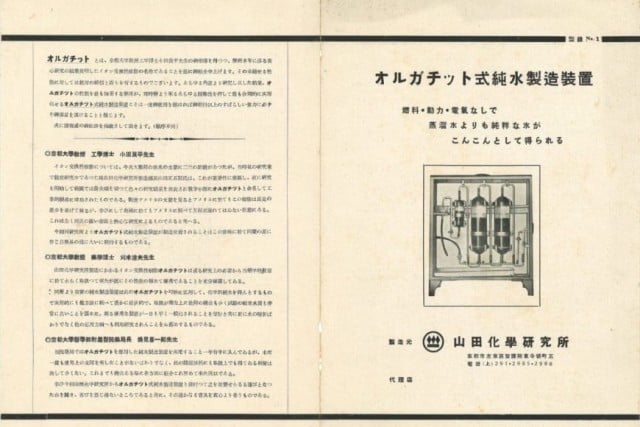
〇 Founded (1994)
~From ion exchange resin to the development of domestic dyes~
In 1944, with support from the Navy, the Yamada Chemical Research Institute was established for the purpose of manufacturing ion exchange resins. The founder, Shogoro Yamada, took part in research on ion exchange resins at university, quickly noticed their usefulness, and succeeded in producing Japan's first ion exchange resin, Orgacit. However, with the end of the war the following year, that demand disappeared. In the post-war chaos, Shogoro began research into textile dyes, making use of the organic synthesis technology he had cultivated. He dreamed of Yamada Chemical's dyes being used in clothing that would brighten up a peaceful and prosperous life.
~From ion exchange resin to the development of domestic dyes~
In 1944, with support from the Navy, the Yamada Chemical Research Institute was established for the purpose of manufacturing ion exchange resins. The founder, Shogoro Yamada, took part in research on ion exchange resins at university, quickly noticed their usefulness, and succeeded in producing Japan's first ion exchange resin, Orgacit. However, with the end of the war the following year, that demand disappeared. In the post-war chaos, Shogoro began research into textile dyes, making use of the organic synthesis technology he had cultivated. He dreamed of Yamada Chemical's dyes being used in clothing that would brighten up a peaceful and prosperous life.
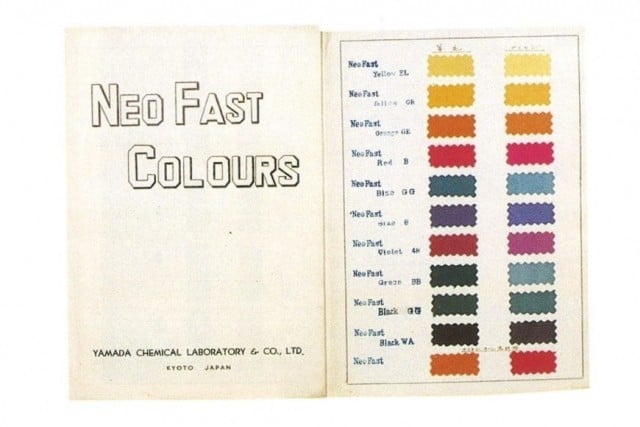
〇 Growth period (1945-1964)
~ Contributing to society through post-war reconstruction and dyes that color society ~
Domestic dyes after the war were mostly cheap products such as sulfur dyes and direct dyes, and high-quality products were still made overseas. Shogoro took on the challenge of researching and manufacturing ``metal complex dyes,'' which had never been produced in Japan, and in 1947 launched ``Neofast Dye,'' Japan's first metal complex dye. Furthermore, he worked on developing dark blue and black chrome dyes (acidic mordant dyes), and in 1951, he launched Chrome Black P2B, which was considered difficult to manufacture at the time. Today, it has become established in the domestic textile industry for use in uniforms and formal suits.
~ Contributing to society through post-war reconstruction and dyes that color society ~
Domestic dyes after the war were mostly cheap products such as sulfur dyes and direct dyes, and high-quality products were still made overseas. Shogoro took on the challenge of researching and manufacturing ``metal complex dyes,'' which had never been produced in Japan, and in 1947 launched ``Neofast Dye,'' Japan's first metal complex dye. Furthermore, he worked on developing dark blue and black chrome dyes (acidic mordant dyes), and in 1951, he launched Chrome Black P2B, which was considered difficult to manufacture at the time. Today, it has become established in the domestic textile industry for use in uniforms and formal suits.

〇 Breakthrough period (1965-1989)
~ With the spread of leuco dyes and OA equipment ~
Pressure-sensitive copying paper developed in the United States came to be used as information recording paper in Japan, and domestic dye manufacturers began developing leuco dyes. With support from trading companies, Yamada Chemical launched the blue leuco dyes CVL and BLMB in 1969. Later, a variety of leuco pigments such as black, green, and red were developed. Leuco dyes are being used in thermal paper applications such as facsimile machines, and demand for them is rapidly increasing. At its peak, our company's leuco dyes boasted the second largest share of the world's production volume and were supported by customers both in Japan and overseas. Currently, it is applied to thermochromic materials and rewritable materials.
~ With the spread of leuco dyes and OA equipment ~
Pressure-sensitive copying paper developed in the United States came to be used as information recording paper in Japan, and domestic dye manufacturers began developing leuco dyes. With support from trading companies, Yamada Chemical launched the blue leuco dyes CVL and BLMB in 1969. Later, a variety of leuco pigments such as black, green, and red were developed. Leuco dyes are being used in thermal paper applications such as facsimile machines, and demand for them is rapidly increasing. At its peak, our company's leuco dyes boasted the second largest share of the world's production volume and were supported by customers both in Japan and overseas. Currently, it is applied to thermochromic materials and rewritable materials.

〇 Turning period (1990-2000)
~In search of new pigments~
As technology advances, digital devices undergo revolutionary evolution. Optical recording media such as CD-R and DVD-R are one of them. Optical recording materials use laser light to thermally change the organic dye in the recording layer, read the reflectance before and after the change, and convert it into a digital signal. In 1995, Yamada Chemical developed a new phthalocyanine dye as a dye for optical recording media. The high-quality sound source reproduction achieved by pigment characteristics was highly praised by experts.
~In search of new pigments~
As technology advances, digital devices undergo revolutionary evolution. Optical recording media such as CD-R and DVD-R are one of them. Optical recording materials use laser light to thermally change the organic dye in the recording layer, read the reflectance before and after the change, and convert it into a digital signal. In 1995, Yamada Chemical developed a new phthalocyanine dye as a dye for optical recording media. The high-quality sound source reproduction achieved by pigment characteristics was highly praised by experts.

〇 Present and future (2000~)
~Functional dyes that support cutting-edge technology~
Yamada Chemical has focused on the development of dyes, focusing on "functional dyes," such as dyes for optical recording media, that go beyond traditional dyeing properties and develop new functions when exposed to light, heat, electric fields, pressure, etc. Ta.
We offer specific wavelength absorption dyes used in optical lenses and filters, as well as luminescent materials and photochromic dyes. There is a lot of interest in Yamada Chemical's products, and it is expected that they will be applied to next-generation products such as electronic materials. As a manufacturer engaged in manufacturing, we will continue to take on the challenge of value creation and technological innovation, and build a new history.
~Functional dyes that support cutting-edge technology~
Yamada Chemical has focused on the development of dyes, focusing on "functional dyes," such as dyes for optical recording media, that go beyond traditional dyeing properties and develop new functions when exposed to light, heat, electric fields, pressure, etc. Ta.
We offer specific wavelength absorption dyes used in optical lenses and filters, as well as luminescent materials and photochromic dyes. There is a lot of interest in Yamada Chemical's products, and it is expected that they will be applied to next-generation products such as electronic materials. As a manufacturer engaged in manufacturing, we will continue to take on the challenge of value creation and technological innovation, and build a new history.

